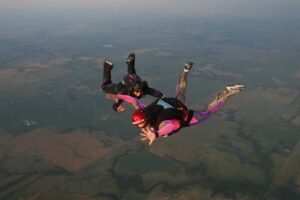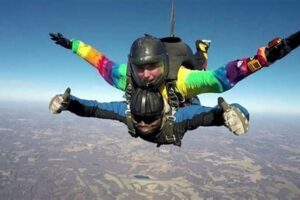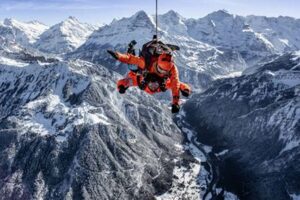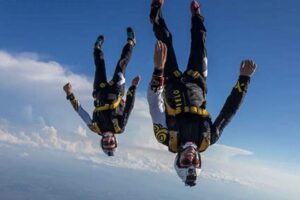Table of Contents
The maximum height for skydiving refers to the highest altitude from which a skydiver can jump and safely deploy their parachute. Typically around 12,500 – 15,000 feet (3,800 – 4,600 meters), this altitude provides ample time and distance for the skydiver to freefall, deploy their parachute, and steer toward a designated landing area.
The max height for skydiving plays a crucial role in providing thrill-seekers with an exhilarating experience. It allows skydivers to enjoy extended freefall periods, experience the beauty of Earth from a unique perspective, and push themselves to new limits. Historically, the max height for skydiving has evolved over time, with advancements in parachute technology and safety regulations enabling skydivers to ascend to higher altitudes and jump from aircraft such as hot air balloons and airplanes.
This article will delve into the factors that determine the max height for skydiving, including safety considerations, atmospheric conditions, and equipment limitations. We will also explore the training and certification requirements necessary to skydive from such altitudes and the challenges and rewards that come with this exhilarating activity.
Max Height for Skydiving
Understanding the various aspects of the max height for skydiving is essential for ensuring safety and maximizing the experience. These include:
- Altitude
- Oxygen levels
- Equipment limitations
- Weather conditions
- Training and certification
- Physical fitness
- Parachute performance
- Emergency procedures
- Legal regulations
Each of these aspects plays a crucial role in determining the maximum height from which a skydiver can jump safely. Altitude affects oxygen levels and air pressure, requiring specialized equipment and training to mitigate potential risks. Weather conditions can impact visibility, wind speeds, and precipitation, influencing the safety and feasibility of a skydive. Physical fitness and training are essential for withstanding the physical and mental challenges of high-altitude skydiving. Parachute performance, emergency procedures, and legal regulations all contribute to ensuring the safety and success of a skydiving experience.
Altitude
Altitude, referring to the height above sea level, is a critical aspect in determining the maximum height for skydiving. Higher altitudes present various challenges and considerations that impact the safety and feasibility of a skydive.
-
Oxygen Levels
As altitude increases, the atmospheric pressure and oxygen levels decrease. This requires skydivers to use supplemental oxygen at higher altitudes to prevent hypoxia (oxygen deprivation).
-
Air Density
Air density decreases with increasing altitude, affecting the drag and lift experienced by the skydiver. This necessitates specialized equipment and techniques to maintain stability and control during freefall.
-
Temperature
Temperatures drop significantly with increasing altitude, posing a risk of hypothermia. Skydivers must wear appropriate clothing and take precautions to stay warm, especially during extended freefall periods.
-
Wind Speed
Wind speed and direction can vary significantly at different altitudes, influencing the trajectory and speed of the skydiver. Strong winds can affect parachute performance and landing accuracy, requiring careful planning and adjustments.
These facets of altitude highlight the complex interplay between atmospheric conditions and skydiving safety. Understanding and managing these factors is crucial for determining the maximum safe altitude for skydiving and ensuring a successful and enjoyable experience.
Oxygen levels
Oxygen levels play a critical role in determining the maximum height for skydiving. As altitude increases, atmospheric pressure and oxygen levels decrease. This decrease in oxygen levels can lead to hypoxia, a condition characterized by oxygen deprivation, which can impair judgment, coordination, and consciousness. Hypoxia can be particularly dangerous for skydivers, as it can occur rapidly at high altitudes and can lead to serious consequences if not addressed promptly.
To mitigate the risk of hypoxia, skydivers who ascend to high altitudes use supplemental oxygen. Supplemental oxygen is typically delivered through a mask or nasal cannula and helps to maintain adequate oxygen levels in the body. The use of supplemental oxygen allows skydivers to safely reach higher altitudes and enjoy extended freefall periods without experiencing the negative effects of hypoxia.
Real-life examples of the importance of oxygen levels in skydiving include the use of oxygen by high-altitude skydivers, such as those attempting to break world records. These skydivers often ascend to altitudes above 30,000 feet, where oxygen levels are extremely low. By using supplemental oxygen, they are able to safely reach these extreme altitudes and perform their jumps without experiencing hypoxia.
The understanding of the relationship between oxygen levels and max height for skydiving has practical applications in ensuring the safety of skydivers. By carefully monitoring oxygen levels and using supplemental oxygen when necessary, skydivers can safely ascend to higher altitudes and enjoy the thrill of skydiving without compromising their safety.
Equipment limitations
Equipment limitations play a critical role in determining the maximum height for skydiving. The equipment used by skydivers, including parachutes, altimeters, and oxygen systems, has inherent limitations that affect the safe maximum altitude for a skydive. These limitations stem from the physical properties of the materials used, design constraints, and safety considerations.
One of the most significant equipment limitations is the performance of parachutes at high altitudes. Parachutes rely on air resistance to slow down the skydiver’s descent. However, as altitude increases, air density decreases, reducing the effectiveness of the parachute. This means that parachutes designed for lower altitudes may not be able to provide sufficient drag at higher altitudes, potentially leading to a dangerous descent rate.
Real-life examples of equipment limitations in max height for skydiving include the use of specialized high-altitude parachutes and oxygen systems. High-altitude parachutes are designed with larger canopies and higher porosity to increase drag and compensate for the reduced air density at higher altitudes. Similarly, skydivers who ascend to extreme altitudes use supplemental oxygen to maintain adequate oxygen levels, as the natural levels of oxygen in the atmosphere decrease with increasing altitude.
The practical applications of understanding the connection between equipment limitations and max height for skydiving are evident in the development and certification of skydiving equipment. Parachute manufacturers design and test their products to ensure they meet specific performance standards, including minimum opening altitudes and descent rates. Skydiving organizations and regulatory bodies establish guidelines for the use of equipment based on these limitations, ensuring the safety of skydivers.
Weather conditions
Weather conditions play a critical role in determining the safety and feasibility of skydiving, particularly when considering the maximum height for a jump. Adverse weather can significantly impact visibility, wind speeds, and precipitation, all of which can affect the skydiver’s ability to navigate, control their descent, and land safely.
-
Wind speed
Strong winds can affect the trajectory and speed of the skydiver, making it difficult to control the descent and land accurately. High winds can also cause the parachute to open prematurely or become entangled, creating a hazardous situation.
-
Visibility
Poor visibility due to fog, clouds, or precipitation can make it difficult for the skydiver to navigate and locate the landing area. This can increase the risk of collision with obstacles or disorientation, especially at high altitudes where there is less time to react.
-
Precipitation
Precipitation, such as rain, snow, or hail, can affect the performance of the parachute by adding weight and reducing its effectiveness. Heavy precipitation can also create updrafts and downdrafts, making it difficult to control the descent and land safely.
-
Lightning
Lightning poses a significant safety hazard to skydivers, as it can occur at high altitudes and travel long distances. Skydiving is typically suspended during thunderstorms due to the risk of lightning strikes, which can cause injury or death.
Understanding the impact of weather conditions on max height for skydiving is essential for ensuring safety and making informed decisions. Skydivers must carefully monitor weather forecasts and conditions before jumping, and be prepared to adjust their plans or postpone the jump if conditions are not favorable. By taking weather conditions into account, skydivers can mitigate risks and maximize the safety and enjoyment of their skydiving experience.
Training and certification
Within the realm of max height skydiving, training and certification stand as indispensable pillars, ensuring that skydivers possess the knowledge, skills, and proficiency to safely execute high-altitude jumps. This section delves into four crucial facets of training and certification, highlighting their significance in the pursuit of max height skydiving.
-
Ground School:
Before taking to the skies, aspiring high-altitude skydivers undergo comprehensive ground school training. This training covers the fundamentals of skydiving, including parachute deployment, emergency procedures, and weather assessment. Ground school provides a solid theoretical foundation for safe and successful skydives at extreme altitudes. -
Tandem Jumps:
For first-time high-altitude skydivers, tandem jumps provide invaluable practical experience. Attached to a highly experienced instructor, they can experience the thrill of high-altitude freefall while learning essential skills such as body position and parachute control. -
Solo Jumps:
After completing the necessary training and gaining experience through tandem jumps, skydivers can progress to solo jumps at high altitudes. These jumps allow them to demonstrate their proficiency in freefall, parachute deployment, and landing techniques, building confidence and independence in the high-altitude environment. -
Continuing Education:
Max height skydiving is a constantly evolving discipline, and ongoing education is paramount for maintaining proficiency. Experienced skydivers regularly participate in training programs, workshops, and currency jumps to stay abreast of the latest techniques, safety protocols, and equipment advancements.
In sum, training and certification are the cornerstones of max height skydiving, empowering skydivers with the knowledge, skills, and confidence to safely explore the limits of high-altitude freefall. Through ground school, tandem jumps, solo jumps, and continuing education, skydivers build a foundation of expertise that enables them to push boundaries while prioritizing safety at all times.
Physical fitness
In the realm of max height skydiving, physical fitness emerges as a critical component, directly influencing a skydiver’s ability to withstand the strenuous demands of high-altitude freefall and execute safe and successful jumps. The connection between physical fitness and max height skydiving is multifaceted, with each aspect impacting the other in a cause-and-effect relationship.
Firstly, excellent physical fitness enables skydivers to endure the physically demanding nature of max height skydiving. The high-altitude environment poses unique challenges, including extreme temperatures, low oxygen levels, and rapid changes in air pressure. A fit body, with strong cardiovascular and muscular systems, allows skydivers to better withstand these rigors and maintain focus and coordination throughout the jump.
Furthermore, physical fitness plays a crucial role in parachute deployment and control. During freefall, skydivers must have the strength and dexterity to manipulate their bodies and deploy their parachutes accurately. Well-developed muscles and good body control enhance a skydiver’s ability to execute these maneuvers smoothly and efficiently, increasing safety and reducing the risk of complications.
Real-life examples abound, showcasing the significance of physical fitness in max height skydiving. Professional high-altitude skydivers undergo rigorous training programs that emphasize cardiovascular fitness, strength training, and flexibility. By maintaining peak physical condition, these skydivers can safely ascend to extreme altitudes and perform complex maneuvers with precision and control.
In summary, physical fitness is an indispensable aspect of max height skydiving, directly contributing to the safety and success of high-altitude jumps. Through its impact on endurance, strength, and coordination, physical fitness empowers skydivers to navigate the challenges of the high-altitude environment, execute precise maneuvers, and maximize their enjoyment of this exhilarating sport.
Parachute performance
In the realm of max height skydiving, parachute performance stands as a pivotal factor, directly influencing the safety and success of jumps from extreme altitudes. Parachute performance encompasses a multitude of aspects, each playing a critical role in ensuring a controlled and safe descent. This section delves into four key facets of parachute performance, exploring their significance and real-life implications in max height skydiving.
-
Canopy Size and Shape
The size and shape of the parachute canopy significantly impact its performance at high altitudes. Larger canopies provide increased drag, slowing down the descent rate and enhancing stability. Specialized canopy designs, such as elliptical or square canopies, offer improved maneuverability and control during freefall.
-
Porosity and Airflow
The porosity of the parachute canopy, or the amount of air that can pass through it, affects its descent rate and stability. High-performance canopies feature optimized porosity, allowing for efficient airflow and precise control during high-altitude jumps.
-
Deployment System
The deployment system, including the pilot chute and main parachute, plays a crucial role in ensuring a smooth and timely parachute opening. Reliable and efficient deployment systems minimize the risk of malfunctions and delays, enhancing safety at extreme altitudes.
-
Maintenance and Inspection
Regular maintenance and inspection of the parachute system are paramount for ensuring optimal performance. Skydivers meticulously inspect their parachutes, checking lines, canopy integrity, and deployment mechanisms, ensuring that their equipment is in top condition before each high-altitude jump.
In conclusion, parachute performance is a multifaceted aspect of max height skydiving, encompassing canopy size and shape, porosity and airflow, deployment system reliability, and regular maintenance. By understanding and optimizing these factors, skydivers can enhance their safety, control, and overall experience when jumping from extreme altitudes.
Emergency procedures
In the realm of max height skydiving, emergency procedures emerge as a critical component, directly influencing the safety and decision-making of skydivers operating at extreme altitudes. Emergency procedures encompass a comprehensive set of protocols and actions designed to mitigate risks and respond effectively to unforeseen circumstances during high-altitude jumps.
The connection between emergency procedures and max height skydiving is inseparable. The unique challenges posed by high altitudes, such as decreased oxygen levels, rapid changes in air pressure, and the potential for equipment malfunctions, necessitate a robust understanding and execution of emergency procedures. Skydivers must be proficient in deploying reserve parachutes, managing malfunctions, and navigating complex scenarios to ensure their safety in the event of an emergency at extreme altitudes.
Real-life examples abound, highlighting the crucial role of emergency procedures in max height skydiving. Professional high-altitude skydivers undergo rigorous training programs that emphasize the practice and mastery of emergency procedures. By developing muscle memory and practicing these procedures in simulated environments, skydivers can respond swiftly and effectively to potential emergencies during actual high-altitude jumps.
The practical applications of understanding the connection between emergency procedures and max height skydiving extend beyond individual safety. By adhering to standardized emergency procedures and undergoing regular training, skydivers contribute to the overall safety culture of the sport. This collective focus on preparedness and risk management enhances the safety of all participants, fosters a sense of community, and promotes continuous improvement in safety protocols.
In conclusion, emergency procedures are an indispensable aspect of max height skydiving, directly contributing to the safety and decision-making of skydivers operating at extreme altitudes. Through training, practice, and a shared understanding of protocols, skydivers can mitigate risks, respond effectively to emergencies, and contribute to the overall safety of the sport.
Legal regulations
Legal regulations play a crucial role in the realm of max height skydiving, establishing a framework of rules and guidelines to ensure the safety and responsible conduct of this extreme sport. These regulations govern various aspects, ranging from licensing and certification to safety protocols and environmental considerations.
-
Licensing and Certification
Legal regulations often require skydivers to obtain licenses or certifications, demonstrating their proficiency and adherence to safety standards. This includes training, experience requirements, and regular medical check-ups.
-
Safety Protocols
Regulations may dictate specific safety protocols for max height skydiving, including minimum altitudes, equipment requirements, and communication procedures. These protocols aim to minimize risks and ensure the well-being of participants.
-
Environmental Considerations
Legal regulations can address environmental concerns related to max height skydiving, such as noise pollution, airspace restrictions, and the protection of wildlife. These regulations help balance the enjoyment of the sport with the preservation of the environment.
Legal regulations play a vital role in promoting safety, fostering responsible practices, and ensuring the long-term sustainability of max height skydiving. By adhering to these regulations, skydivers contribute to a culture of safety and respect for the environment, while also enjoying the thrill and exhilaration of this unique sport.
Frequently Asked Questions
This FAQ section provides answers to some of the most common questions regarding the maximum height for skydiving and related aspects.
Question 1: What is the typical maximum height for skydiving?
Answer: The typical maximum height for skydiving ranges from 12,500 to 15,000 feet (3,800 to 4,600 meters), depending on factors such as safety regulations, weather conditions, and equipment capabilities.
Question 2: How does altitude affect skydiving?
Answer: Increasing altitude generally leads to decreased oxygen levels, increased air density, and lower temperatures. These factors necessitate specialized equipment and procedures to ensure safety during high-altitude skydives.
Question 3: What equipment is used for high-altitude skydiving?
Answer: High-altitude skydiving requires specialized equipment, including parachutes with larger canopies and higher porosity, supplemental oxygen systems, and altimeters with higher accuracy and precision.
Question 4: What training is necessary for max height skydiving?
Answer: Max height skydiving requires extensive training, including ground school, tandem jumps, solo jumps, and ongoing education to maintain proficiency and stay abreast of safety protocols.
Question 5: What are the safety considerations for max height skydiving?
Answer: Safety considerations include weather conditions, equipment reliability, physical fitness, emergency procedures, and legal regulations. Skydivers must carefully evaluate these factors and take appropriate measures to mitigate risks.
Question 6: What are the physical demands of max height skydiving?
Answer: Max height skydiving requires excellent physical fitness, including cardiovascular endurance, muscular strength, and body control to withstand the rigors of high-altitude freefall and parachute deployment.
These FAQs provide a brief overview of the key considerations related to max height for skydiving. For further insights into the challenges and techniques involved in this exhilarating activity, refer to the following sections of the article.
(Transition to the next article section)
Tips for Safe and Enjoyable High-Altitude Skydiving
This section provides crucial tips to help skydivers safely and enjoyably execute max height skydives. By following these recommendations, skydivers can enhance their preparedness, minimize risks, and maximize the exhilaration of this extreme sport.
Tip 1: Undergo Comprehensive Training: Invest in thorough training from certified instructors, covering ground school, tandem jumps, and solo jumps, to develop a solid foundation in skydiving techniques and safety procedures.
Tip 2: Prioritize Physical Fitness: Maintain excellent physical fitness through regular exercise and a balanced diet. Strong cardiovascular health, muscular endurance, and body control are essential for withstanding the demands of high-altitude skydiving.
Tip 3: Choose Reliable Equipment: Invest in high-quality, well-maintained skydiving equipment, including a suitable parachute system, altimeter, and communication devices. Regular inspections and servicing are crucial to ensure optimal performance.
Tip 4: Monitor Weather Conditions: Carefully assess weather forecasts and conditions before each jump. Favorable conditions, such as clear skies, calm winds, and good visibility, contribute to a safer and more enjoyable skydiving experience.
Tip 5: Follow Emergency Procedures: Familiarize yourself with emergency procedures and practice them regularly. This includes deploying reserve parachutes, managing malfunctions, and communicating with other skydivers in case of unexpected situations.
Tip 6: Stay Informed: Keep up-to-date with the latest safety protocols, equipment advancements, and best practices in high-altitude skydiving. Attend workshops, read industry publications, and engage with experienced skydivers to continuously enhance your knowledge and skills.
By adhering to these tips, skydivers can significantly enhance their safety and enjoyment during max height skydives. These measures empower skydivers to approach this exhilarating sport with confidence and focus on maximizing the thrill and exhilaration it offers.
(Transition to the article’s conclusion) In the concluding section, we will delve into the profound impact of safety and preparation on the overall skydiving experience. By embracing a safety-first mindset and diligently implementing these tips, skydivers can unlock the full potential of high-altitude skydiving and create lasting memories.
Conclusion
Throughout this exploration of the max height for skydiving, we have uncovered the intricate interplay of factors that influence the safety and thrill of this extreme sport. From the physiological demands of high altitudes to the technical complexities of parachute performance, a comprehensive understanding of these aspects is paramount for skydivers seeking to push the boundaries of their sport.
Key insights from our discussion include the critical importance of physical fitness and training, the need for reliable equipment and adherence to safety protocols, and the value of ongoing education and situational awareness. These elements are interconnected, forming a holistic approach to max height skydiving that prioritizes safety while maximizing the exhilaration and fulfillment it offers.







